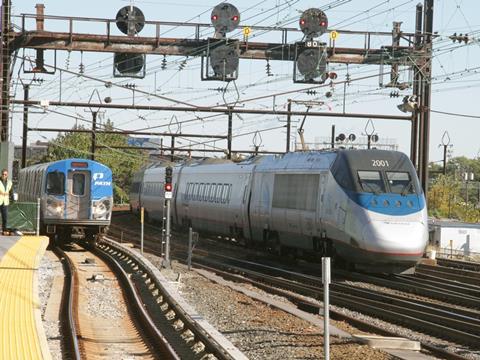
USA: Amtrak and the NEC Commission consortium of stakeholders in the USA’s busiest passenger rail route have updated their plans for modernisation of the 735 km Northeast Corridor linking Boston with New York City and Washington DC, following the award of federal funding.
The Connect NEC 2037 document builds on the Connect NEC 2035 plan set out in July 21, but Amtrak says that ‘for the first time’, the programme will now benefit ‘from dedicated funding for the corridor’s most urgent capital repairs and improvements’.
On November 6, the Federal Railroad Administration awarded funds totalling $16·4bn to support 25 passenger rail enhancement interventions along the Northeast Corridor. These were selected through the Bipartisan Infrastructure Law’s Federal-State Partnership for Intercity Passenger Rail programme. However, Amtrak emphasised in its Connect 2037 announcement, that ‘while BIL funds will go a long way toward rebuilding the NEC, continued annual funding appropriated by Congress and guaranteed funding beyond [the 2026 financial year] are needed to realise the full benefits of this plan’.
The scope of the vision, if fully funded and implemented, would cover the rebuilding of the corridor’s critical infrastructure to enable faster, more reliable, and more frequent trains, more services to link ‘underserved communities’, and more resilient infrastructure.
More inter-city and commuter trains
In terms of service provision, the plan envisages 50% more Amtrak trains between Boston and New York, and a near-doubling of the service between New York and Washington. There would be a 60% increase in commuter trains, including provision for MBTA trains to link Boston and Providence in less than 1 h. New York MTA’s Metro-North operation is expected to add 51 trains per day on the New Haven line serving New York Penn Station, while the MARC service between Washington and Baltimore would increase from 27 to 37 trains each way per day.
NEC passengers would be offered a direct Metro-North service between New York City and Waterbury in Connecticut, while a potential new link between New York City, Hartford, and Springfield would be provided by Amtrak.
The vision includes development of what the partners term a ‘New York City metro’. This would see a rush-hour service of six Amtrak and 42 New Jersey Transit trains per hour crossing the Hudson River between New York and New Jersey, subject to completion of the Gateway Programme to boost rail capacity between the two states.
NJ Transit is expected to introduce a direct all-day service on its Raritan Valley route to exploit the additional infrastructure. ‘Significant off-corridor investments will need to be made to realise the full benefits of the Gateway Programme’, the partners add.
Modal shift
In sum, Amtrak and the NEC Commission of 18 stakeholders, including eight state governments and the District of Columbia, the various commuter rail operators and the federal Department of Transportation, believe the 2037 plan would attract an additional 51 million passengers per annum to the corridor. This would shift approximately 38 million annual car trips and nearly 600 000 short-haul flights to rail.
The plan also addresses the corridor’s resilience in the face of a changing climate. The C37 investments would keep passengers moving ‘by addressing delays and cancellations due to flooding, extreme heat, severe weather events, or infrastructure failures’, it says.
‘A modern, reliable Northeast Corridor is essential to the region’s economic future’, said Amtrak Chief Executive Stephen Gardner on November 17. ‘Amtrak ridership on the Northeast Corridor is at all-time record levels, and the projects included in this plan will provide the capacity, reliability, and service improvements that our customers need and deserve.’
‘Predictable funding is essential to the meaningful planning and efficient delivery of this 15-year major rail improvement programme’, added Laura Mason, Executive Vice President of Major Project Delivery at Amtrak. ‘With long-term funding sources through the Bipartisan Infrastructure Law, the NEC’s rail agencies can hire workforces, procure equipment, and advance project engineering with confidence that projects will have the funding needed to enter construction.’

















